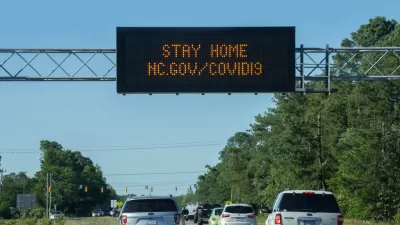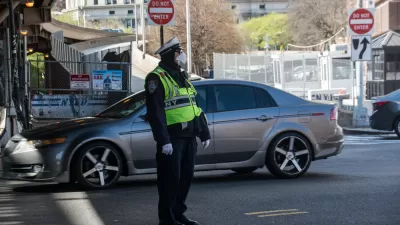A 9 percent increase in fatalities on the nation's highways compared to the same period in 2015 does not appear to be a result of increased driving, which jumped 3.3 percent during that period, but rather an increase in the rate of fatal crashes.
Note the rising red line beginning in 2014 in the National Safety Council chart below that accompanied their Aug. 23 press release:

The fatality rate increased from 1.2 deaths per 100 million vehicle miles traveled to 1.3 deaths, an increase of 8.3 percent, just shy of the percentage increase in total deaths. On Aug. 22, the Federal Highway Administration reported that total mileage driven the first six months of 2016 increased 3.3 percent.
NSC estimates that 2.2 million people were seriously injured (requiring medical attention) during the first six months of the year.
The report casts an ominous sign for the coming Labor Day holiday weekend. National Safety Council (NSC) estimates [PDF] that 438 people will die during the upcoming three-day holiday weekend, the most since 2008.
The data are estimates
NSC lowered their Aug. 17, 2015 estimate of traffic fatalities for the first 6 months of 2015 from 18,600, a 14 percent increase over 2014, to 17,530. Last year at this time NSC projected that fatalities were "on track to exceed 40,000 traffic deaths." The increase was in fact 8 percent, and the year's total was 38,300.
Readers may be curious about the discrepancy with reporting from the National Highway Traffic Safety Administration, which estimated 2015 fatalities at 35,200 in their July report. NSC uses a different database than NHTSA, as our February post on an NSC report explains.
If the trend continues, "which shows no signs of decreasing...the U.S. may see its deadliest driving year since 2007 and deadliest Labor Day since 2008," according to the 100-year-old group.
A supplemental Motor Vehicle Fatality Estimate sheet [PDF] projects the year-end total at 39,870 [Table 1.]
According to NSC, the three main causes of traffic fatalities last year were:
- Alcohol (30.8%). [Note: Driving under the influence of drugs is a major factor as well.]
- Speeding (30%)
- Distracted driving (26%)
"States that have been particularly hard hit since 2014, the start of the upward trend, are Florida (43% increase), Georgia (34%), Indiana (33%), California (31%), North Carolina (26%), Illinois (24%) and Kentucky (24%)," reports NSC. [See Table 2 (PDF) for precise data].
Last September, the Sacramento Bee (via Planetizen) distinguished the increase in miles traveled from the increase in fatalities. Traffic deaths in the nation's most populous state have been on the risen since 2010 after decreasing from 2006 to 2010.
"In some ways, the connection seems obvious: More people on the roads means more fatal encounters," wrote Tony Bizjak.
But state highway officials say that doesn’t have to be the case. Having more cars on the roads doesn’t always lead to more crashes. In some instances, crowded roads can make driving safer by forcing motorists to slow down and pay more attention. (For instance, crash rates on rural roads are higher than on urban streets.)
For additional media accounts on the National Safety Council report, see AP and Streetsblog.
FULL STORY: Motor Vehicle Fatalities Up 9%; No Sign of a Decrease in 2016, says National Safety Council

Maui's Vacation Rental Debate Turns Ugly
Verbal attacks, misinformation campaigns and fistfights plague a high-stakes debate to convert thousands of vacation rentals into long-term housing.

Planetizen Federal Action Tracker
A weekly monitor of how Trump’s orders and actions are impacting planners and planning in America.

San Francisco Suspends Traffic Calming Amidst Record Deaths
Citing “a challenging fiscal landscape,” the city will cease the program on the heels of 42 traffic deaths, including 24 pedestrians.

Defunct Pittsburgh Power Plant to Become Residential Tower
A decommissioned steam heat plant will be redeveloped into almost 100 affordable housing units.

Trump Prompts Restructuring of Transportation Research Board in “Unprecedented Overreach”
The TRB has eliminated more than half of its committees including those focused on climate, equity, and cities.

Amtrak Rolls Out New Orleans to Alabama “Mardi Gras” Train
The new service will operate morning and evening departures between Mobile and New Orleans.
Urban Design for Planners 1: Software Tools
This six-course series explores essential urban design concepts using open source software and equips planners with the tools they need to participate fully in the urban design process.
Planning for Universal Design
Learn the tools for implementing Universal Design in planning regulations.
Heyer Gruel & Associates PA
JM Goldson LLC
Custer County Colorado
City of Camden Redevelopment Agency
City of Astoria
Transportation Research & Education Center (TREC) at Portland State University
Jefferson Parish Government
Camden Redevelopment Agency
City of Claremont





























